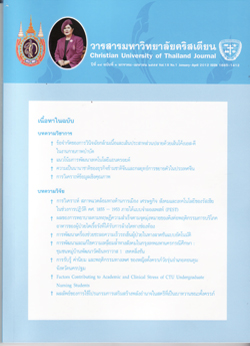ข้อจำกัดของการวินิจฉัยกล้ามเนื้อและเส้นประสาทส่วนปลาย ด้วยเส้นโค้งเอส-ดีในงานกายภาพบำบัด
บทคัดย่อ
เส้นโค้งเอส-ดี ถูกนำมาใช้วินิจฉัยและรักษาในผู้ป่วยที่มีความผิดปกติของกล้ามเนื้อและเส้นประสาทส่วนปลายอย่างกว้างขวางในงานกายภาพบำบัด เนื่องจากเป็นวิธีที่ประหยัดกว่าวิธีการทดสอบความเร็วในการนำกระแสประสาทของเส้นประสาทส่วนปลาย และวิธีทดสอบสัญญาณไฟฟ้าของกล้ามเนื้อ เส้นโค้งเอส-ดี เป็นกราฟที่แสดงความสัมพันธ์ระหว่างความแรงของกระแสไฟที่ใช้ในการกระตุ้นเนื้อเยื่อ ในระดับที่สามารถทำให้เกิดการตอบสนองได้ และช่วงกระตุ้นที่ปล่อยกระแสไฟฟ้าเข้าสู่เนื้อเยื่อ เพื่อแสดงคุณลักษณะของกล้ามเนื้อและเส้นประสาท แม้ว่าหลักการทางประสาทสรีรวิทยาของเส้นโค้งเอส-ดีได้ถูกสร้างขึ้นและเผยแพร่มานานแล้วก็ตาม แต่ยังมีปัจจัยหลายประการที่มีผลกระทบต่อความน่าเชื่อถือ และความเที่ยงตรงของการหาค่าโครแน็กซี่ ซึ่งได้แก่ รูปร่างกระแสไฟ ขั้วกระตุ้น ความต้านทานของกระแส ความแตกต่างของเนื้อเยื่อ และอุณหภูมิ ในทางปฏิบัติ นักกายภาพบำบัดควรใช้ไฟรูปร่างสี่เหลี่ยมกระตุ้นด้วยขั้วลบที่ส่งจากแหล่งผลิตแบบกระแสไฟคงที่ และต้องทดสอบกล้ามเนื้อหลายมัดที่เลี้ยงโดยเส้นประสาทนั้นๆ เพื่อให้ได้เส้นโค้งเอส-ดีที่น่าเชื่อถือมากที่สุด
เอกสารอ้างอิง
Andrew J. Robinson and Lynn Snyder-Mackler. (2007). Clinical electrophysiology : electrotherapy and electrophysiologic testing. 3rd edition. Philadelphia : Lippincott Williams & Wilkins.
Caruso P. N., Pearce J. A., and DeWitt D. P. (1979). Temperature and current density distributions at electrosurgical dispersive electrode sites. Proc. N. Eng. Bioeng. Conf. 7(1) : 373-376.
Friedli WG and Meyer M . (1984). Strength-duration curve: a measure for assessing sensory deficit in peripheral neuropathy. J Neurol Neurosurg Psychiatry. 47(2) : 184-189.
Gasser H. S. and Erlanger J. (1927).The role played by the sizes of the constituent fibers of a nerve trunk in determining the form of its action potential wave. Amer. J. Physiol., 80(1):522-547.
_______ . (1922). A study of the action currents of nerve with the cathode ray oscilloscope. Amer. J. Physiol. 62(1) : 496-524.
Geddes L. A. and Bourland J. D. (1985). The strength-duration curve. IEEE Trans. Biomed. Eng. 32(1) : 458-459.
_______ .(1985). Tissue stimulation : theoretical considerations and practical applications. Med. Biol. Eng. 23(2) : 131-137.
Geddes L. A. (1999). Chronaxie. Austral. Phys. Eng. Sci. Med. Biol. 22(1).13-17.
________ . (1997). Evolution of circuit models for the electrode-electrolyte interface. Ann. Biomed Eng. 25(1) : 1-14.
________. (2004). Accuracy limitations of Chronaxie value. IEEE Trans. Biomed. Eng. 51(1) : 176 - 181.
Hill A. V.(1935). Excitation and accommodation in nerve. Proc. Roy. Soc. B119 : 305-354.
Hodgkin A. L. (1939). The subthreshold potentials in a crustacean nerve fiber. J. Physiol. 126(1): 87-121.
_______ . (1951). The ionic basis of electrical activity in nerve and muscle. Biol. Rev. 26 : 339-409.
Irnich W. (1980). The chronaxie time and its practical importance. PACE. 3(1) : 292-301.
Lapicque L. (1907). Influence d'une variation locale de temp?rature su l'excitabilit?du nerf moteur. Comptes Rendus Soc: de Biol. 62(1) : 35-37.
Lucas K. (1906). The analysis of complex excitable tissues by their response to electric currents of short duration. J. Physiol. 35(1) : 310-331.
Overmeyer K. M., Pearce J. A., and DeWitt D. P. (1979). Measurement of temperature distribution at electrosurgical dispersive electrode sites. J. Biomech. Eng.10(1) : 66-72.
Ritchie A. and Smith C. R. (1944). The electrical diagnosis of peripheral nerve injury. Brain. 67(1). 314-330.
Wessale J. L., Geddes L. A., Ayers G. M., and Foster K. S. (1992). Comparison of rectangular and exponential pulses for evoking sensation. Ann.Biomed. Eng. 20(1) : 237-244.



